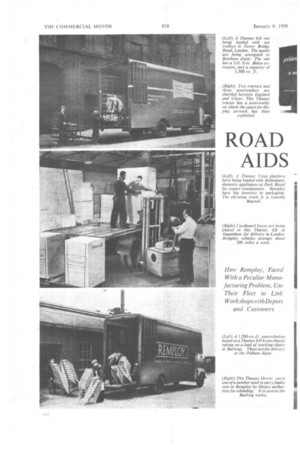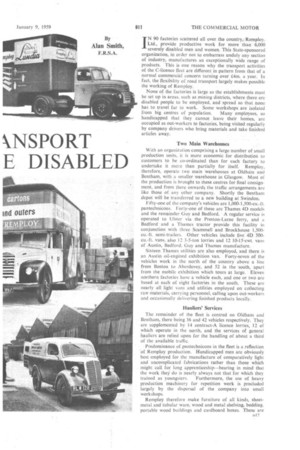ROAD kNSPORT AIDS E DISABLED
Page 60

Page 61

Page 62

If you've noticed an error in this article please click here to report it so we can fix it.
By
Alan Smith,
F.R.S.A.
IN 90 factories scattered all over the country,-\Remploy, Ltd., provide productive work for more than '6;000 severely disabled men and women. This State-sponsored organization, in order not to embarrass unduly any section of industry, manufactures an exceptionally wide range of products. This is one reason why the transport activities of the C-licence fleet are different in pattern from that of a normal commercial concern turning over £4m, a year. In fact, the flexibility of road transport largely makes possible the working of Remploy.
None of the factories is large as the establishments must be set up in areas, such as mining districts, where there are disabled people to be employed, and spread so that hone has to travel far to work. Some workshops are isolated
from big centres of population. Many employees, so handicapped that they cannot leave their homes, are occupied as out-workers to factories, being visited regularly by company drivers who bring materials and take finished articles away.
Two Main Warehouses
With an organization comprising a large number of small production units, it is more economic for distribution to customers to be co-ordinated than •for each factory to undertake it more than partially for itself. Remploy, therefore, operate two main warehouses at Oldham and Bentham, with a smaller warehouse in Glasgow. Most of the production is brought to these centres for final consignment, and from there onwards the traffic arrangements are like those of.. any other company. Shortly the Bentham depot will be transferred to a new building at Swindon.
Fifty-one of the company's vehicles are 1,000-1,500-cu.-ft. pantechnicons. Forty-one of these are Thames 4D models and the remainder Guy and Bedford. A regular service is operated to Ulster via the Preston-Larne ferry, and a 'Bedford • and a Thames tractor provide this facility in conjunction with three Scammell and Brockhouse 1,500cu.-ft. semi-trailers. Other vehicles include five '4D 500cu.-ft. vans, also 12 3-5-ton lorries and 12 10-15-cwt, vans of Austin, Bedford, Guy and Thames manufacture.
Sixteen Thames utilities are also employed, and there is an Austin oil-engined exhibition van. Forty-seven of the vehicles work in the north of the country above a line from Boston to Aberdovey, and 52 in the south, apart from the mobile exhibition which tours at large. Eleven northern factories have a vehicle each, and one or two are based at each of eight factories in the south. These are nearly all light vans and utilities employed on collecting raw materials, carrying personnel, calling upon out-workers and occasionally delivering finished products locally.
Hauliers' Services The remainder of the fleet is centred on Oldham and Bentham, there being 36 and 42 vehicles respectively. They are supplemented by 14 contract-A licence lorries, 12 of which operate in the north, and the services of general hauliers are relied upon for the handling of about a third of the available traffic.
• 'Predominance of pantechnicons in the fleet is a reflection Of Remploy production. Handicapped men are obviously best employed for the manufacture of comparatively light and uncomplicated fabrications rather than those which might call for long apprenticeship—bearing in mind that the work the do is nearly always not that for which they
trained as youngsters. Furthermore, the use of heavy production machinery for repetition work is precluded largely by the dispersal of the company into small workshops.
Remploy therefore make furniture of all kinds, sheetmetal and tubular ware, wood and metal shelving, bedding, portable wood buildings and cardboard boxes. These are n17
bulky goods which require transport in large-capacity vans. Although furniture and the other items mentioned preponderate in the company's output, there is a diversity of other functions, including the manufacture of knitwear, protective clothing, leather goods, electrical elements and heaters, orthopedic appliances, also light, engineering, bookbinding and packaging. Packaging represents a division. which preserves and packs for storage all manner of metal components ranging from nuts and bolts to -axles and machinery.
Some of these activities involve the use of ordinarylorries, but these are mainly engaged upon transporting raw materials. The vans nearly all have coniposite bodywork by Messrs. Howards, of West 'Ham, and have integral cabs with, on the latest types, translucent roof panels. Use of articulated boxvans will be taken a step further next year when bulk loads will . be trunked between Oldham and Swindon.
Vehicles .average about 500 miles a week, delivering to wholesalers, factories, shops, hospitals and schools, as well as docks with export traffic. Because Remploy workshops are fairly widespread, itis often possible to find return loads for vehicles which may travel a .long way from base.
Unexpectedly good results have come from the use of the mobile exhibition. This has a Sparshattbody 24 ft. long and 7 ft. 6 in. high, giving ample space for a display of kitchen cabinets, dining suites and other products. A 12-ft. side flap may be raised so that the exhibits can be seen from the .outside. Retailers in various towns are invited to .inspect the exhibition, and area salesmen have reported increases in orders of .50 per.cent. or more after the vehicle has attended in their districts'.
%Vehicles based in the north, are serviced at Oldham depot, where facilities exist for repair and replacement work not involving special machining. In the south, main te.nance is entrusted to the trade, but the position will be similar to that at Oldham because a garage and workshop is being installed at Swindon. There is a monthly dock for servicing and inspection. Engine oils are changed at 3,000
miles and transmission oils at 6,000 miles. , During the past three years, the fleet has become predominantly oil-engined in the heavier classes, chiefly because of the adoption of the 4D. This type made an early appeal because of its competitive cost and has since averaged 22 m.p.g: with up to 80,000 mites run before need arises for decarbonizing and new piston rings.
Maintenance and tyre records are kept so that the performances of individual vehicles may be checked and compared, and costs are computed by means of PowersSamas punched-card apparatus. Standing charges comprise: tax, insurance, depreciation, repairs, wages and establishment costs. Running expenses are: fuel, overtime, servicing, oil, subsistence allowances, and tyres. Each of these items has a code reference, and there are additional references for actual costs of repairs and tyres, the headings mentioned in the standing charges and running
expenses being notional allotments. From time to time these may be compared with actual outlay.
























































































































